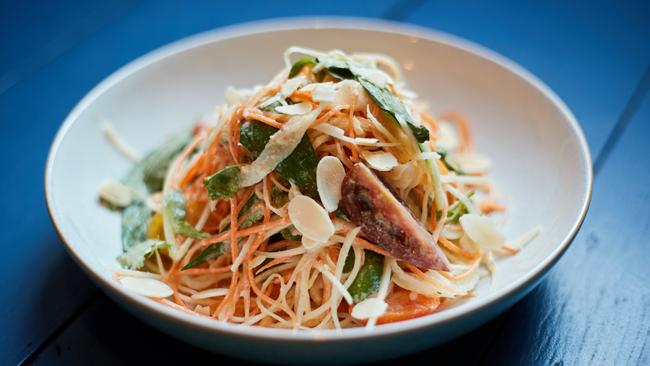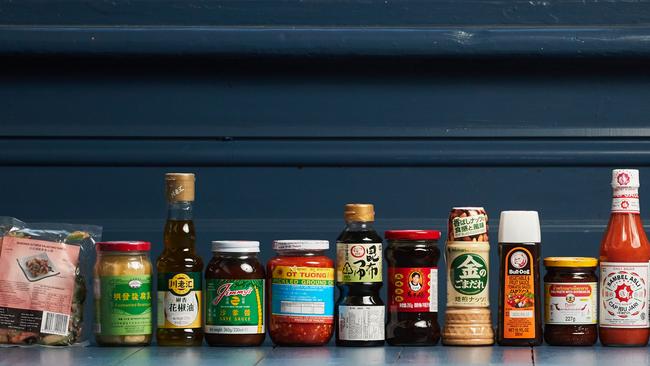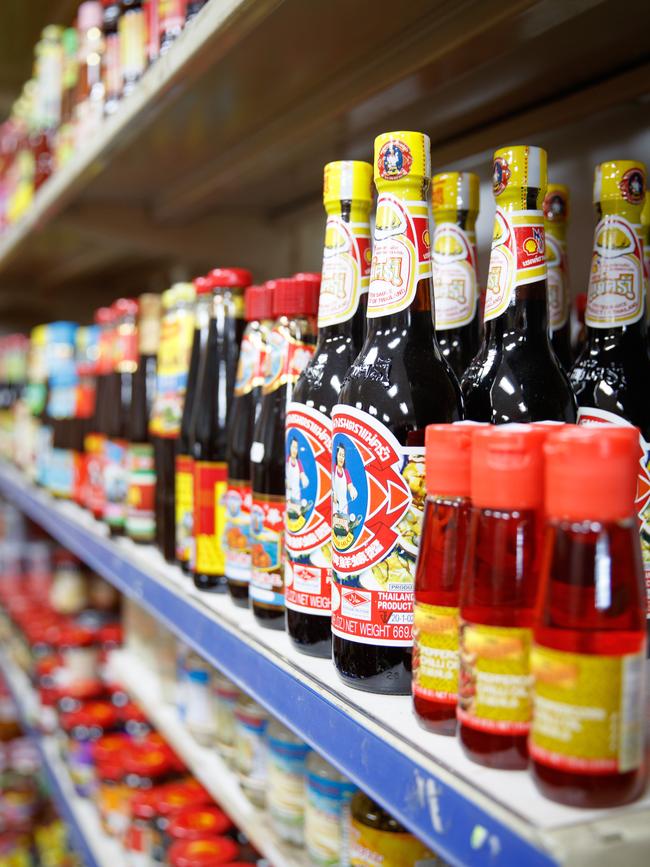Ultimate guide to Asian sauces: What to buy and how to use it
Here’s how to get the most out of the colourful array of bottles and jars in the aisles of your local Asian supermarket. From Sichuan oil to fermented bean curd, learn how to use the best sauces to give your meals a flavour kick.

Eating Out
Don't miss out on the headlines from Eating Out. Followed categories will be added to My News.
A sizzling wok pungent with the smells of chilli, garlic and ginger. The lemongrass and galangal that make a Thai curry or tom yum sing. Satays and beef rendang. A chilli sauce that goes on everything from fried eggs to hamburgers.
The firework flavours of Asia have become part of our everyday diets but few home cooks have the time to chop, grind and blend all the ingredients needed for many of the pastes and sauces.
That’s where the colourful array of bottles, jars and packets in the aisles of an Asian supermarket come in, providing a shortcut solution for midweek dinners that doesn’t have to break the bank, as many of the products are priced under $5 and most keep in the fridge for months.
But with such a vast selection to choose from, and many of the labels confusing, where do you start?
Chef and Asian cuisine specialist Josh Kim shares his favourites that will deliver a quick flavour hit for those times you can’t — or simply can’t be bothered to — make something from scratch.
“It’s very hard to have all the fresh ingredients (at home) to make something like a curry paste or tom yum paste,” he says.
“But if you have a good product to use to make flavour for a meal, it is really good. With a few vegetables, noodles or rice, they can make an instant dinner.”
Here are his picks:

YANAN BRIDGE FERMENTED BEAN CURD
Don’t be put off by the pong when you open the jar, Kim says.
These little blocks of fermented bean curd can be used to make a smooth, creamy sauce that is great with stir-fried vegetables.
“It reminds me of salty, whipped butter but with a tang,” he says.
“It has a creamy, smooth, paste texture but when you open the jar it smells really funky.
“That doesn’t mean it is off. And once it is cooked, the smell goes away. But you still have that nice fermented flavour.”
He says Chinese and South-East Asian restaurants will often serve stir-fried vegetables with fermented bean curd sauce.
Kim recommends blending the curd until smooth and then using it “like you would for something like oyster sauce” with garlic, chilli and other flavours.
CLH SICHUAN PEPPERCORN OIL
The first advice here is “be careful”. A little of this oil, that captures the numbing, mouth-tingling, prickly quality of Sichuan pepper, can go a long way. Too much could easily spoil a dish.
Using the oil is a timesaving way of introducing the unique Sichuan flavour, Kim says, and also avoids any potential grittiness of the ground product.
“The first time when you try it you might not like it, but when you get used to it, it is good,” he says.
“I really like to drop some of that oil in my Korean-style instant noodles, maybe with some sliced meat. If you want to go crazy with it, that’s fine, but start with a little bit.”
Kim says the oil will also work well in any Sichuan-leaning stir-fry that also uses dried chilli, or to give extra seasoning to sliced meats from a Chinese/Vietnamese barbecue shop quickly stir-fried with garlic, salt and maybe oyster sauce.
JIMMY’S SATE SAUCE
Who doesn’t love satay/sate sauce and its sweet, nutty, slightly spicy taste? While the one made from scratch might still be best, this is a great shortcut alternative, Kim says.
“This brand is one of the best you can get,” he says.
“It has more texture and flavour and I think it has a little dried prawn in there. It’s not really hot but it is quite rich.”
Kim says he like to use the sauce with a hotpot or as a dipping sauce. But you could also used with skewers of grilled chicken, beef or lamb, both in a marinade before cooking and a sauce afterwards — basically, anywhere you would use a satay sauce.

OT TUONG PICKLED GROUND CHILLI
A base for any dish where you would normally start by frying finely chopped garlic and chilli, this paste also adds a little pickled flavour and saltiness, Kim says.
Use for a stir-fry, in dipping sauces such as nuoc cham or nam jim, or even to add some bite to a sweet chilli sauce.
WADAKAN SEASONING SAUCE
Ordinary soy can look a little dull when compared with this Japanese condiment that adds flavours such as dried seaweed (kombu), mushroom and bonito into the mix for extra complexity and umami punch.
“A drop of this can really enhance the flavour,” says Kim, who likes to use it in dumpling fillings, for seasoning soups or even to give a boost to a tomato sauce to go with pasta. “When I’m not getting enough flavour from the tomatoes, a tablespoon will add a little natural MSG.”
LAO GAN MA FERMENTED SOYA BEANS WITH CHILLI OIL
The brand translates to “Old Godmother”, a reference to its founder, who developed a global following for the chilli sauces she started selling to local students.
“Lao Gan Ma is famous in China and around the world for its jars of chilli paste,” Kim says. “There are lots of different versions, some with peanuts or mushrooms in there. But this is the black beans one which has a more salty and deep flavour. It has lots of secret ingredients in there so we don’t know everything it is made from.”
Kim says you can just mix it with rice, perhaps adding spring onions and other vegetables. Add a spoonful or two to a stir-fry to make it spicy and add lots of extra flavour.
It can also go into soups or the base of a hotpot. It is a basic, master ingredient.
MIZKAN SESAME SAUCE
A ready-made dressing for salads and steamed vegetables.
“It’s terrific with a Japanese-style slaw of cabbage on a simple mesclun leaf salad,” Kim says. “You can use it on steamed beans but it’s even better on grilled broccolini or asparagus, where it picks up the toasty, nutty flavour. Just open it and it’s ready.”
BULL-DOG VEGETABLE & FRUIT SAUCE
While this Japanese tonkatsu sauce is designed chiefly to go with fried food, such as crumbed pork, or drizzled over the thick savoury pancake okonomiyaki, it can also take the place of a standard barbecue sauce in your fridge door.
“The difference between western sauces is that (this one) uses vegetables, such as carrots, tomatoes and apples, for the sweet flavour and not as much sugar,” Kim says. “So it could be a bit healthier and it has way better flavour.” Use it on steak, sausages or wherever else you like barbecue sauce.

PANTAI CHILLI PASTE WITH SOYBEAN OIL
Another chilli paste, this jar comes from Thailand and contains dried shrimp and fish sauce, making it good for South-East Asian cooking.
“When you open it you can see flaky meat of prawn in there and you can smell the fish and prawn,” Kim says. “It gives you extra flavour in a stir-fry and a curry, when you need more than just chilli.”
He advises this will work better in Thai- or Indonesian-style cooking, rather than Indian or Chinese.
“But you can also use it when you cook pasta with prawn,” he says. “Add a teaspoon of this and it makes it taste as if you have made up a special prawn butter.”
SAMBEL ASLI CHILLI SAUCE
Kim makes a big call here: Sambel Asli, he says, is a better chilli sauce than sriracha, the condiment that has people around the world addicted.
“Sriracha has a big kick at the start and in the end you are left with an MSG flavour,” he explains.
“This one doesn’t feel all that spicy in the beginning but it has a richer flavour and more body to it. It’s only when it’s finished in your mouth then it starts to burn.”
Made in Indonesia, Sambel Asli can be used anywhere you might find sriracha, perhaps with wings, in a dipping sauce or blended into mayo.
LEE KUM KEE XO SAUCE
The only product to break the $10 barrier (it was $11.50), this sauce in a stylish hexagonal box is kept on a shelf at the front of Kim Wang, near other higher-priced items, such as royal jelly. The XO name denotes its luxury status (like XO cognac), as its ingredients can include dried scallop, dried shrimp and ham.
“Some other brands you can’t see the dried seafood, but this one you can,” Kim says. “It’s really strong essence of flavour.”
He likes to use XO in a stir-fry with pipis, fish or vermicelli style noodles.
MELBOURNE’S BEST NEW ITALIAN RESTAURANTS
THE CHINESE YOU PROBABLY HAVEN’T TRIED
BUMBU RENDANG
This is a good base for a rendang-style curry, Kim says, with plenty of flavour.
“It has a beautiful, aromatic smell and you could also use for a stir-fry, soup or even a secret dipping sauce.” The paste contains ginger, galangal, lemongrass and turmeric, so stick to South-East Asian-style dishes.
PENTA TOM YUM PASTE
The same could be said for this tom yum paste, a good base for the Thai soup.
“When I ask my Thai friends, this is the one they go for,” Kim says.
He uses it to make a sauce for stir-fried vegetables, such as mushrooms and gai lan, or fried rice.
WJT SPICY SANSI
Chilli-hot pickled vegetables that are ready to use as a snack or accompaniment. They could also be added into a salad, stir-fry or sour-style soup for extra texture and flavour.



